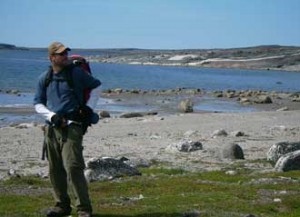
By McGill Reporter Staff
McGill rocks, old school…like 4.3 billion years old.
Testing conducted in April has shown that rock samples collected on the eastern shores of James Bay by a team that included two McGill researchers are approximately 4.28 billion years old, making them the oldest rocks on Earth. The results of the team’s research were published in the September 26 issue of the journal Science.
Up until now, rocks found in the Northwest Territories in 1989 were thought to be the Earth’s most ancient. The Quebec rocks, however, outdate them by some 300 million years.
The discovery was made by Jonathan O’Neil, a Ph.D. candidate at McGill’s Department of Earth and Planetary Sciences, Richard W. Carlson, a researcher at the Carnegie Institution for Science in Washington, D.C., Don Francis, a McGill professor in the Department of Earth and Planetary Sciences, and Ross K. Stevenson, a professor at the Université du Québec à Montréal. O’Neil was the lead researcher.
The rocks, known as “faux-amphibolites,” may be remnants of a portion of Earth’s primordial crust – the first crust that formed at the surface of our planet. They were found along the Hudson Bay coast, 40 km south of Inukjuak in an area known as the Nuvvuagittuq greenstone belt.
O’Neil and colleagues estimated the age of the rocks using isotopic dating, which analyzes the isotope neodymium-142 within them, produced from the decay of the isotope samarium-146. This technique can only be used to date rocks roughly 4.1 billion years old or older; this is the first time it has ever been used to date terrestrial rocks, because nothing this old has ever been discovered before.
The data from these findings will give researchers a new window on the early separation of Earth’s mantle from the crust in the Hadean Era, said O’Neil.
“Our discovery not only opens the door to further unlock the secrets of the Earth’s beginnings,” he continued. “Geologists now have a new playground to explore how and when life began, what the atmosphere may have looked like, and when the first continent formed.”
